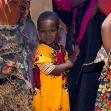

Media CenterUganda now hosts more than 1 million South Sudanese refugees as hunger crisis worsens
FOR IMMEDIATE RELEASE
CONTACT:
Michael Stulman
Catholic Relief Services
221 77 370 3037
[email protected]
Brutal conflict and drought push the numbers of refugees facing
severe hunger to more than 30 million in East Africa alone
NAIROBI, KENYA/BALTIMORE, MD, August 17, 2017 – The numbers are staggering, but no one is paying any attention. In East Africa alone, more than 30 million people are facing shocking levels of hunger, with many of them entirely dependent on food aid for their very survival until the beginning of 2018. Yet that is premised on the hopes that the next harvests will finally be decent. But for three years, harvests have been dismal, brought on by a deadly blend of El-Nino-driven desiccating drought and brutal conflict that keeps people confined to massive camps for refugees.
While South Sudan recently feted that a famine declaration had been lifted in several hunger hotspots in the country, there is nothing to celebrate. Hunger has continued to worsen, as plantings were limited when rains got underway in July and as conflict has spread and become more extreme.
“People fixate on the actual ‘famine’ stage,” said Jerry Farrell, CRS Country Representative in South Sudan. “The reality is, if we wait until famine is declared officially, still, thousands of people will be dying of hunger. It’s a major emergency, and it’s only continuing to get worse. We’re splitting hairs when people – especially children – are already dying from hunger.”
According to the most recent data, 6 million South Sudanese – the equivalent of the entire population of Missouri - are now in need of food assistance for their survival, and, when soon seemingly ‘normal’ staples like water lilies run out in September, the descent toward famine will only accelerate. In fact, the UN and other agencies warn that people stranded on islands in the middle of the White Nile, where they seek refuge from marauding attackers, could already be in famine.
Humanitarian access in South Sudan has been largely cut off, including in these very areas where CRS works, delivering food and development assistance to nearly 900,000.
In other countries across East Africa, the situation is no better. In Ethiopia, the numbers of people who rely on emergency food aid was recently amended upward, to 8.5 million people, and that is in addition to 8 million in Ethiopia who are on the national government’s safety net food assistance programs. That 8.5 million people could steadily increase to about 15 million people by the end of 2017. The Kenyan government also announced at the end of July that the number of people in need of food aid had increased, due to the same climate stresses as well as spikes in food prizes and invasive pests.
CRS is also assisting people affected by conflict and famine in Yemen, where 17 million people are facing famine due to conflict. Yemenis are flooding into areas of Somalia, itself brutalized by the current drought and its own searing conflict. A wide-scale catastrophe has so far been largely averted thanks to humanitarian assistance – funded by the U.S. government and currently at risk of being cut in the federal budget process - in Somalia, as well as in South Sudan and Ethiopia.
“It is mind-boggling that the U.S. Administration at this very moment is pushing to slash international disaster response and development programs, when they are currently providing critical lifesaving and developmental assistance across East Africa,” said Matt Davis, regional director for CRS in East Africa. “Our two biggest programs globally are in East Africa, namely Ethiopia and South Sudan, and they absolutely depend on the generosity of the United States and USAID’s Office of Food for Peace and the Office of US Foreign Disaster Assistance during these critical periods.”
“When you have Uganda taking in 1 million South Sudanese refugees, while the US has suspended processing of refugee applications, you have to wonder about our moral compass at this moment, when so many are in need. People’s lives aren’t just numbers,” Davis said.
###
Catholic Relief Services is the official international humanitarian agency of the Catholic community in the United States. The agency alleviates suffering and provides assistance to people in need in more than 100 countries, without regard to race, religion or nationality. CRS’ relief and development work is accomplished through programs of emergency response, HIV, health, agriculture, education, microfinance and peacebuilding. For more information, please visit crs.org or crsespanol.org and follow CRS on social media: Facebook, @CatholicRelief, @CRSnews, YouTube, Instagram and Pinterest.




